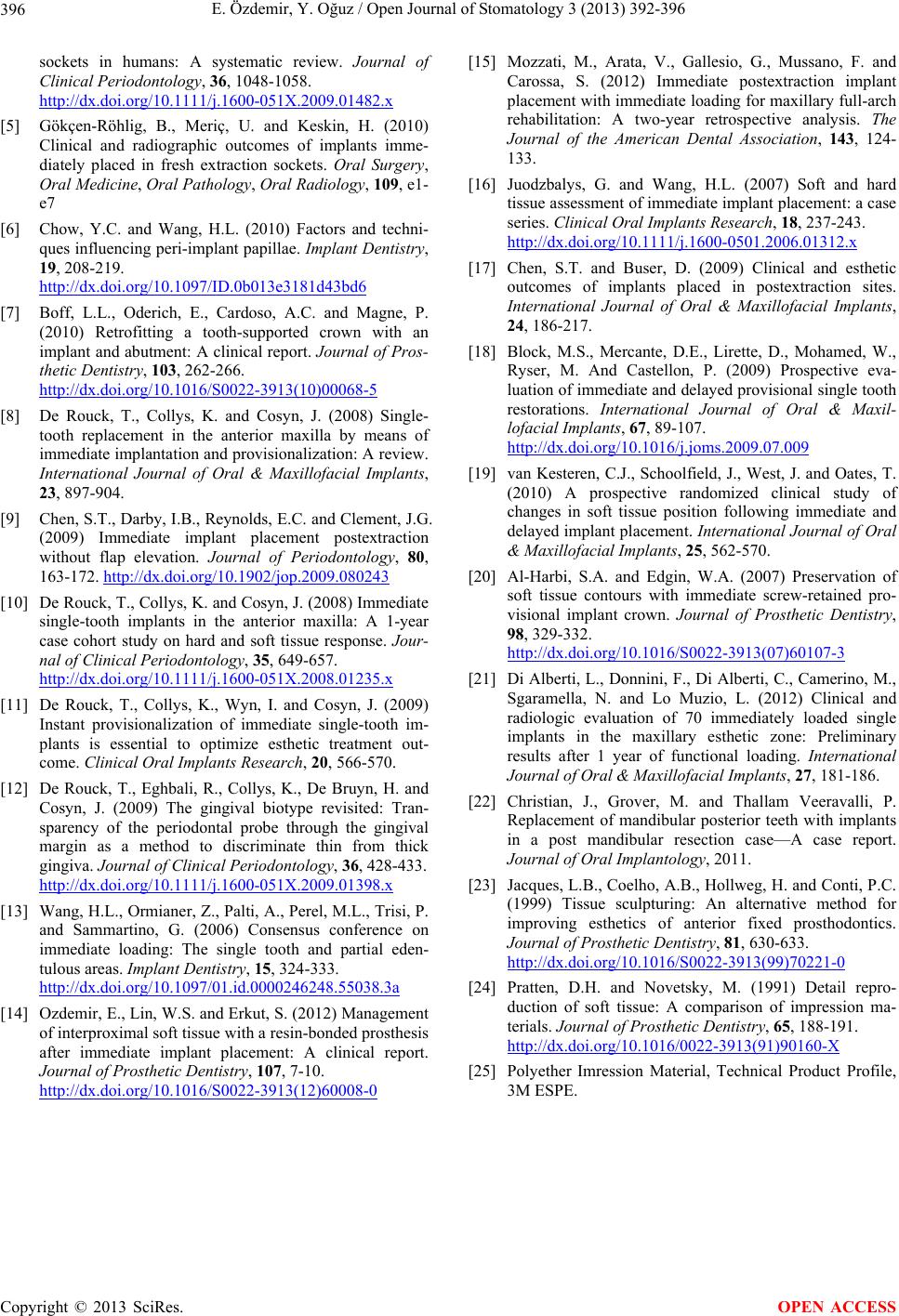
E. Özdemir, Y. Oğuz / Open Journal of Stomatology 3 (2013) 392-396
Copyright © 2013 SciRes.
396
OPEN ACCESS
sockets in humans: A systematic review. Journal of
Clinical Periodontology, 36, 1048-1058.
http://dx.doi.org/10.1111/j.1600-051X.2009.01482.x
[5] Gökçen-Röhlig, B., Meriç, U. and Keskin, H. (2010)
Clinical and radiographic outcomes of implants imme-
diately placed in fresh extraction sockets. Oral Surgery,
Oral Medicine, Oral Pathology, Oral Radiology, 109, e1-
e7
[6] Chow, Y.C. and Wang, H.L. (2010) Factors and techni-
ques influencing peri-implant papillae. Implant Dentistry,
19, 208-219.
http://dx.doi.org/10.1097/ID.0b013e3181d43bd6
[7] Boff, L.L., Oderich, E., Cardoso, A.C. and Magne, P.
(2010) Retrofitting a tooth-supported crown with an
implant and abutment: A clinical report. Journal of Pros-
thetic Dentistry, 103, 262-266.
http://dx.doi.org/10.1016/S0022-3913(10)00068-5
[8] De Rouck, T., Collys, K. and Cosyn, J. (2008) Single-
tooth replacement in the anterior maxilla by means of
immediate implantation and provisionalization: A review.
International Journal of Oral & Maxillofacial Implants,
23, 897-904.
[9] Chen, S.T., Darby, I.B., Reynolds, E.C. and Clement, J.G.
(2009) Immediate implant placement postextraction
without flap elevation. Journal of Periodontology, 80,
163-172. http://dx.doi.org/10.1902/jop.2009.080243
[10] De Rouck, T., Collys, K. and Cosyn, J. (2008) Immediate
single-tooth implants in the anterior maxilla: A 1-year
case cohort study on hard and soft tissue response. Jour-
nal of Clinical Periodontology, 35, 649-657.
http://dx.doi.org/10.1111/j.1600-051X.2008.01235.x
[11] De Rouck, T., Collys, K., Wyn, I. and Cosyn, J. (2009)
Instant provisionalization of immediate single-tooth im-
plants is essential to optimize esthetic treatment out-
come. Clinical Oral Implants Research, 20, 566-570.
[12] De Rouck, T., Eghbali, R., Collys, K., De Bruyn, H. and
Cosyn, J. (2009) The gingival biotype revisited: Tran-
sparency of the periodontal probe through the gingival
margin as a method to discriminate thin from thick
gingiva. Journal of Clinical Periodontology, 36, 428-433.
http://dx.doi.org/10.1111/j.1600-051X.2009.01398.x
[13] Wang, H.L., Ormianer, Z., Palti, A., Perel, M.L., Trisi, P.
and Sammartino, G. (2006) Consensus conference on
immediate loading: The single tooth and partial eden-
tulous areas. Implant Dentistry, 15, 324-333.
http://dx.doi.org/10.1097/01.id.0000246248.55038.3a
[14] Ozdemir, E., Lin, W.S. and Erkut, S. (2012) Management
of interproximal soft tissue with a resin-bonded prosthesis
after immediate implant placement: A clinical report.
Journal of Prosthetic Dentistry, 107, 7-10.
http://dx.doi.org/10.1016/S0022-3913(12)60008-0
[15] Mozzati, M., Arata, V., Gallesio, G., Mussano, F. and
Carossa, S. (2012) Immediate postextraction implant
placement with immediate loading for maxillary full-arch
rehabilitation: A two-year retrospective analysis. The
Journal of the American Dental Association, 143, 124-
133.
[16] Juodzbalys, G. and Wang, H.L. (2007) Soft and hard
tissue assessment of immediate implant placement: a case
series. Clinical Oral Implants Research, 18, 237-243.
http://dx.doi.org/10.1111/j.1600-0501.2006.01312.x
[17] Chen, S.T. and Buser, D. (2009) Clinical and esthetic
outcomes of implants placed in postextraction sites.
International Journal of Oral & Maxillofacial Implants,
24, 186-217.
[18] Block, M.S., Mercante, D.E., Lirette, D., Mohamed, W.,
Ryser, M. And Castellon, P. (2009) Prospective eva-
luation of immediate and delayed provisional single tooth
restorations. International Journal of Oral & Maxil-
lofacial Implants, 67, 89-107.
http://dx.doi.org/10.1016/j.joms.2009.07.009
[19] van Kesteren, C.J., Schoolfield, J., West, J. and Oates, T.
(2010) A prospective randomized clinical study of
changes in soft tissue position following immediate and
delayed implant placement. International Journal of Oral
& Maxillofacial Implants, 25, 562-570.
[20] Al-Harbi, S.A. and Edgin, W.A. (2007) Preservation of
soft tissue contours with immediate screw-retained pro-
visional implant crown. Journal of Prosthetic Dentistry,
98, 329-332.
http://dx.doi.org/10.1016/S0022-3913(07)60107-3
[21] Di Alberti, L., Donnini, F., Di Alberti, C., Camerino, M.,
Sgaramella, N. and Lo Muzio, L. (2012) Clinical and
radiologic evaluation of 70 immediately loaded single
implants in the maxillary esthetic zone: Preliminary
results after 1 year of functional loading. International
Journal of Oral & Maxillofacial Implants, 27, 181-186.
[22] Christian, J., Grover, M. and Thallam Veeravalli, P.
Replacement of mandibular posterior teeth with implants
in a post mandibular resection case—A case report.
Journal of Oral Implantology, 2011.
[23] Jacques, L.B., Coelho, A.B., Hollweg, H. and Conti, P.C.
(1999) Tissue sculpturing: An alternative method for
improving esthetics of anterior fixed prosthodontics.
Journal of Prosthetic Dentistry, 81, 630-633.
http://dx.doi.org/10.1016/S0022-3913(99)70221-0
[24] Pratten, D.H. and Novetsky, M. (1991) Detail repro-
duction of soft tissue: A comparison of impression ma-
terials. Journal of Prosthetic Dentistry, 65, 188-191.
http://dx.doi.org/10.1016/0022-3913(91)90160-X
[25] Polyether Imression Material, Technical Product Profile,
3M ESPE.